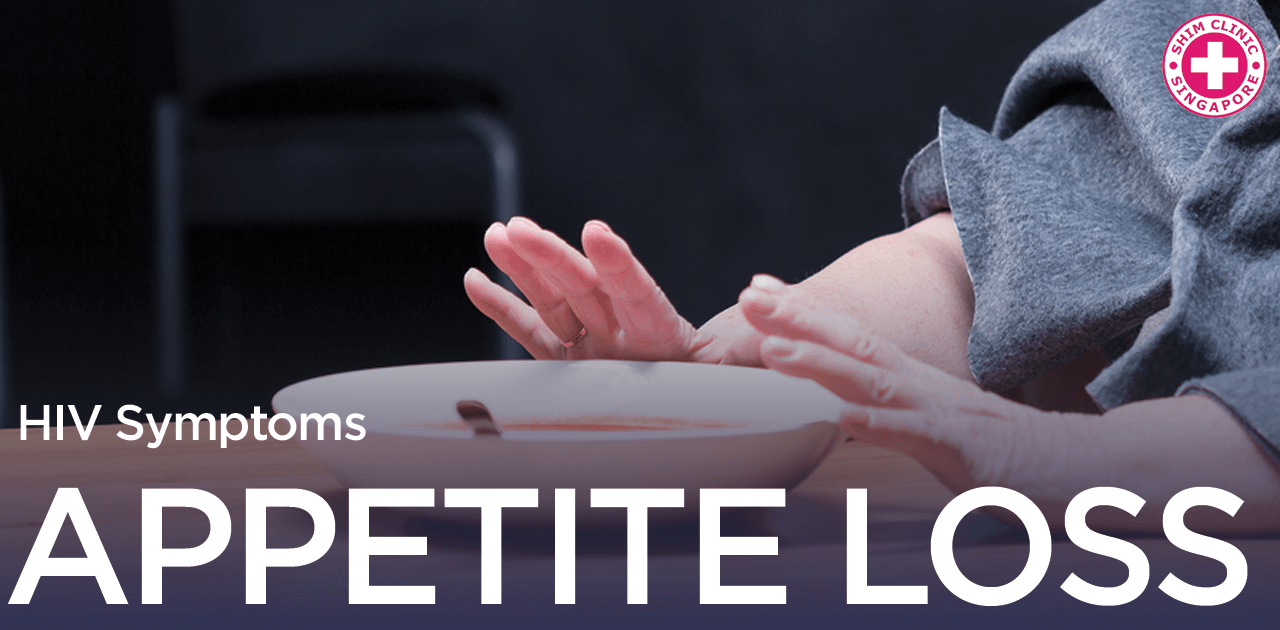HIV Appetite Loss Singapore | Shim Clinic
| Help me about HIV Appetite Loss ! |

| Permalink: https://shimclinic.sg/hiv-appetite-loss |
Symptoms of acute HIV infection begin two to four weeks after the exposure, and can last for a few weeks. One common symptom is appetite loss. There may or may not be nausea along with the loss of appetite. This is also a symptom of many other infections, so an HIV test is needed.
Symptoms of acute HIV infection begin two to four weeks after the exposure occurs. They are generalized symptoms of illness. However, they tend to last longer than most infections, up to a few weeks. By contrast, a common infection like influenza usually gets better in seven to ten days. Some people don’t experience any symptoms of acute HIV infection, while others do.
Among the common symptoms of acute HIV infection is appetite loss. People may find that they simply have no interest in food. There may also be nausea along with the loss of appetite, but not always; many people just simply don’t feel much like eating. There may also be other symptoms, such as fever and malaise (a general ill feeling). For some people, the decreased appetite is the first symptom they notice. Those you normally eat with may notice it, sometimes even before you notice it yourself.
You’ve likely experienced a decreased appetite when you had common viral infections, such as influenza. This is a common response to an infection. When the immune system is working hard to fight an infection, the body doesn’t have much energy left over for functions like digestion. Instead, the energy usually used to digest food will be diverted to fighting off the pathogens, and you experience a loss of appetite.
- Symptoms of acute HIV infection begin two to four weeks after the exposure, and can last for up to a few weeks. Not everyone has symptoms.
- One of the common symptoms is appetite loss, which may or may not include nausea.
- This is a common symptom of many different infections and is not specific to HIV.
- Make sure that you disclose any possible exposures to HIV, such as having unprotected sex, having a condom break or leak while having sex, sharing equipment while injecting drugs, or being stuck with a needle if you’re a healthcare worker.
Because it’s a common symptom of many infections, it isn’t always obvious that appetite loss is a result of acute HIV infection. It can also be due to other uncommon causes, like cancer. It takes testing to figure out what’s causing your loss of appetite, along with any other symptoms you may have. If they are actually HIV symptoms, you’ll need an HIV test to be diagnosed.
Make sure that you disclose any possible exposures to HIV, so that your doctor will know to do an HIV test. You should tell your doctor when these exposures occurred, so he or she can do the right type of HIV test. Possible ways to be exposed to HIV include having unprotected sex, having a condom break or leak while having sex, sharing equipment while injecting drugs, or being stuck with a needle if you’re a healthcare worker.
Sources:
Mayo Clinic. “STD symptoms: Common STDs and their symptoms.” Mayo Clinic. Published 18 Mar 2015. Accessed 20 Jul 2016. http://www.mayoclinic.org/std-symptoms/art-20047081
Centers for Disease Control and Prevention. “Screening Recommendations Referenced in Treatment Guidelines and Original Recommendation Sources.” Centers for Disease Control and Prevention. Published 04 Jun 2015. Accessed 20 Jul 2016. http://www.cdc.gov/std/tg2015/screening-recommendations.htm
Centers for Disease Control and Prevention. “HIV/AIDS.” Centers for Disease Control and Prevention. Published 05 Jul 2016. Accessed 27 Jul 2016. http://www.cdc.gov/hiv/
Centers for Disease Control and Prevention. “HIV Basics – Testing.” Centers for Disease Control and Prevention. Published 12 Jul 2016. Accessed 20 Jul 2016. http://www.cdc.gov/hiv/basics/testing.html
U.S. Department of Health & Human Services. “Post-Exposure Prophylaxis (PEP).” AIDS.gov. Published 21 Sep 2015. Accessed 20 Jul 2016. https://www.aids.gov/hiv-aids-basics/prevention/reduce-your-risk/post-exposure-prophylaxis/
| Timeline | HIV | STD | Pregnancy |
|---|---|---|---|
| Before exposure | |||
| Contraception (females only) | |||
| HIV PrEP (pre-exposure prophylaxis) - Stop HIV infection before exposure | STD vaccine: - Hepatitis vaccine - HPV vaccine | ||
| STD / HIV exposure | |||
| 0-72 hours | HIV PEP (post-exposure prophylaxis) - Stop HIV infection after exposure | STD testing * - Screening test - to look for asymptomatic infections - from previous exposures | Emergency contraception with the morning-after pill (females only) |
| 2 weeks | HIV DNA Test | ||
| 1 month | HIV 4th Generation Test - SD Bioline HIV Ag/Ab Combo - Fingerprick blood sampling. - 20 minutes to results | ||
| 3 months | HIV 3rd Generation Test - OraQuick® HIV-1/2 Antibody - Oral fluid or - Fingerprick blood sampling. - 20 minutes to results | STD testing * - Full & comprehensive - diagnostic test - to look for current infections | |
| Watch for | HIV Symptoms | STD Symptoms | |
| If infected | HIV Treatment | STD Treatment | Abortion |
References